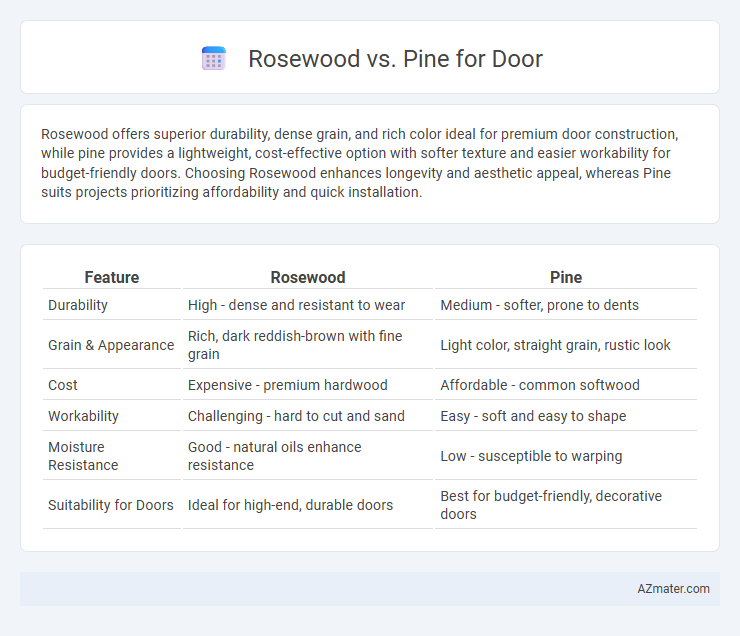Rosewood offers superior durability, dense grain, and rich color ideal for premium door construction, while pine provides a lightweight, cost-effective option with softer texture and easier workability for budget-friendly doors. Choosing Rosewood enhances longevity and aesthetic appeal, whereas Pine suits projects prioritizing affordability and quick installation.
Table of Comparison
| Feature | Rosewood | Pine |
|---|---|---|
| Durability | High - dense and resistant to wear | Medium - softer, prone to dents |
| Grain & Appearance | Rich, dark reddish-brown with fine grain | Light color, straight grain, rustic look |
| Cost | Expensive - premium hardwood | Affordable - common softwood |
| Workability | Challenging - hard to cut and sand | Easy - soft and easy to shape |
| Moisture Resistance | Good - natural oils enhance resistance | Low - susceptible to warping |
| Suitability for Doors | Ideal for high-end, durable doors | Best for budget-friendly, decorative doors |
Introduction to Rosewood and Pine for Doors
Rosewood is prized for its durability, rich color, and natural resistance to decay, making it an excellent choice for high-end doors that demand both strength and aesthetic appeal. Pine, a softwood known for its affordability and ease of workability, offers a lightweight option ideal for interior doors or budget-conscious projects. Both woods vary in grain patterns and finish options, influencing the final look and performance of residential or commercial door applications.
Key Characteristics of Rosewood
Rosewood is prized for its dense grain, deep reddish-brown hue, and natural durability, making it an excellent choice for doors requiring both strength and aesthetic appeal. Its resistance to rot and insect damage outperforms pine, which is softer and more prone to dents and scratches. The rich color and fine texture of rosewood add a sophisticated, high-end look to doors, while pine's lighter tone offers a more rustic and affordable alternative.
Key Properties of Pine Wood
Pine wood, known for its lightweight and easy workability, features a pale yellow to light brown color with a straight grain pattern that enhances its aesthetic appeal in door construction. Its moderate hardness and good dimensional stability make pine a cost-effective choice for interior doors, offering resistance to warping and shrinking under varying humidity conditions. The natural resin content in pine provides some resistance to decay and insect attacks, though it requires proper sealing and maintenance to ensure long-term durability.
Durability Comparison: Rosewood vs Pine
Rosewood exhibits superior durability compared to pine, making it an ideal choice for doors subjected to heavy use and varying weather conditions. Its dense grain structure resists warping, cracking, and insect damage better than the softer, more porous pine. Pine doors may require additional treatments and maintenance to achieve comparable longevity and resilience.
Aesthetic Differences Between Rosewood and Pine
Rosewood doors exhibit a rich, dark, and luxurious grain pattern with deep reddish-brown hues that enhance the elegance and sophistication of interior spaces. Pine doors, on the other hand, feature a lighter, softer appearance with pale-yellow tones and prominent knots, offering a more rustic and natural charm. The distinct contrast between rosewood's dense, polished texture and pine's casual, warm look makes each wood ideal for different aesthetic preferences and design styles.
Cost Analysis: Rosewood vs Pine Doors
Rosewood doors generally cost significantly more than pine doors due to the hardwood's density, durability, and rich grain patterns that increase manufacturing expenses. Pine doors offer an affordable alternative with lower material and production costs but require more frequent maintenance to prevent dents and scratches. Choosing between rosewood and pine depends on budget constraints and desired longevity, with rosewood providing long-term value and pine catering to cost-sensitive projects.
Maintenance and Longevity
Rosewood doors offer superior durability and require minimal maintenance due to their natural resistance to moisture, insects, and warping, making them ideal for long-lasting use. Pine doors are more prone to dents, scratches, and moisture damage, necessitating regular sealing and repainting to maintain their appearance and structural integrity. Despite higher initial costs, rosewood delivers extended longevity and reduces long-term upkeep expenses compared to pine.
Environmental Impact and Sustainability
Rosewood doors are often criticized for their environmental impact due to the slow growth rate of rosewood trees and the associated illegal logging practices, leading to deforestation and habitat loss. Pine, on the other hand, is a fast-growing softwood that is more sustainable, as it is typically harvested from managed forests with replanting programs, resulting in a lower ecological footprint. Choosing pine doors supports sustainable forestry initiatives and reduces the environmental harm compared to the more ecologically sensitive rosewood options.
Best Applications for Rosewood and Pine Doors
Rosewood doors excel in high-end applications requiring durability, rich aesthetics, and natural resistance to moisture, making them ideal for luxury interiors, main entrance doors, and decorative paneling. Pine doors are best suited for cost-effective, lightweight interior doors where ease of customization and paintability are prioritized, such as bedroom or closet doors. The natural hardness and grain of rosewood provide long-lasting performance, while pine's softness allows for versatile design and budget-friendly options.
Conclusion: Choosing the Right Wood for Your Door
Rosewood offers exceptional durability, rich color, and resistance to wear, making it ideal for high-end doors that combine luxury and longevity. Pine is more affordable, easier to work with, and provides a lighter, rustic aesthetic, suitable for budget-friendly or interior doors. Selecting between rosewood and pine depends on your priorities for cost, appearance, durability, and maintenance requirements to achieve the best door performance and style.

Infographic: Rosewood vs Pine for Door
 azmater.com
azmater.com